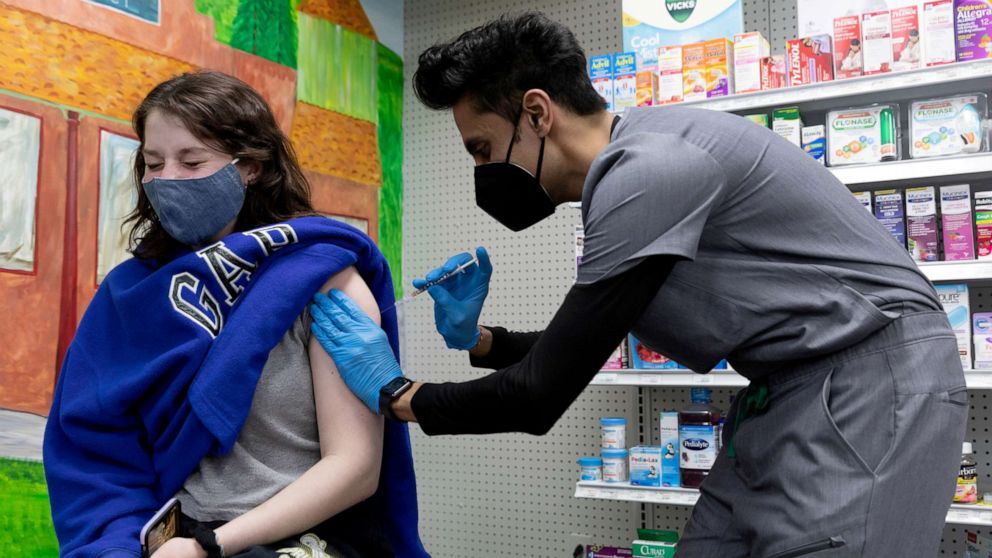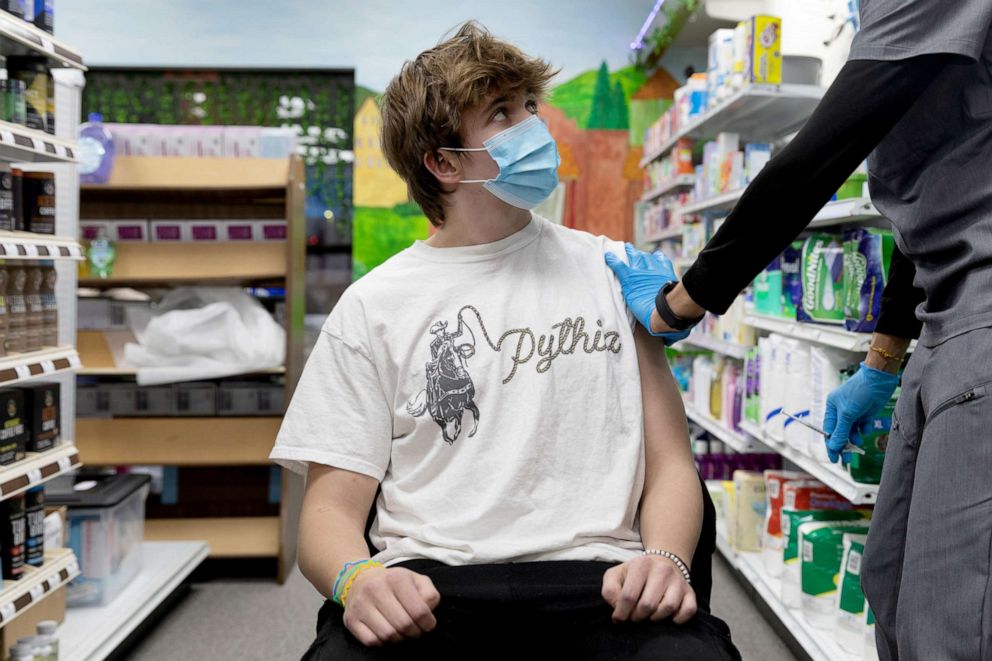疾病控制和预防中心正在推动年轻的美国人接种冠状病毒疫苗,因为数据显示他们明显落后于其他年龄组。
根据该机构周一发布的一份报告,截至5月22日,只有38%的18至29岁的美国人至少接种了一剂新冠肺炎疫苗。报告称,相比之下,57%的18岁以上美国人和80%的美国老年人在此期间至少打了一针。
该报告称:“根据目前的每周启动率(截至5月22日),到8月底,年轻人的覆盖率将达不到老年人的水平。”。
截至周一,1.77亿美国人(约占美国总人口的53%)至少接种了一剂疫苗,疾控中心说。

汉娜·贝尔/路透社,文件
患有狼疮的18岁的朱莉娅·加兹比接受了辉瑞-生物技术公司的抗冠状病毒疫苗
疾控中心对18岁至39岁的美国人进行的一项调查发现,23%的受访者表示,他们不确定是否接种疫苗,但可能会接种。根据疾控中心的数据,大约四分之一的受访者表示他们肯定不会接种疫苗。
该报告发现,受访者的决定背后有不同的原因。
报告称,对于那些没有接受注射但可能在未来完成注射的年轻美国人来说,最大的担忧是潜在的副作用。根据调查,没有注射疫苗的其他原因包括等待看看他们是否安全,以及认为其他人比他们更需要疫苗。
根据该报告,表示不会接种疫苗的受访者还表示,副作用是一个问题,同时对疫苗缺乏信任或认为他们不需要疫苗。
根据疾病预防控制中心的数据,这项调查在3月至5月间对大约2700人进行了调查。
该机构强调,提高美国年轻人疫苗接种率的关键是教育,因为调查显示,三分之二的受访者表示,他们没有足够的疫苗安全信息。
“不确定或可能会接种疫苗的人报告说,如果他们有更多的信息表明疫苗是安全的(39.0%),有效的(28.8%),将防止他们向家人和朋友传播新冠肺炎病毒(27.6%),并将允许他们恢复社会活动(20.9%),他们将被激励接种疫苗,”报告说。

汉娜·贝尔/路透社,文件
17岁的马克斯·多布尔斯在接受辉瑞-生物技术公司的抗结核疫苗之前,看了看马扬克·阿明医生
疾控中心表示,最有帮助的方法是从可信的来源,如卫生当局、初级保健医生以及家人和朋友那里提供关于安全性和有效性的准确信息。
几个研究表明新冠肺炎疫苗减少了由病毒引起的死亡、严重症状和住院,早期研究表明它们对预防几种变体。
卫生专家指出,随着越来越多的人接受疫苗,疫苗已经在全国范围内实时显示出其有效性。
新增病例的平均7天时间从4月19日批准全国所有成年人接种疫苗时的64622例下降到6月17日的11432例。疾控中心的数据显示。根据疾病预防控制中心的数据,同期每天新增死亡人数的七天平均值从641人下降到284人。
任何需要帮助安排免费疫苗预约的人都可以登录vaccines.gov
Young adult vaccination rate lags behind other age groups, CDC finds
The Centers for Disease Control and Prevention is pushing younger Americans to get their coronavirus vaccines, as data shows they are significantly lagging behind other age groups.
As of May 22, only 38% of Americans between the ages 18 to 29 received at least one COVID-19 vaccine dose, according to a report released by the agency Monday. By comparison, 57% of all Americans over 18 and 80% of all U.S. senior citizens had at least one shot during that period, the report said.
"Based on the current rate of weekly initiation (as of May 22), younger persons will not reach the same levels of coverage as older persons by the end of August," the report said.
As of Monday, 177 million Americans, roughly 53% of the entire U.S. population has received at least one vaccine dose,the CDC said.
A CDC survey of Americans between the ages of 18 and 39 found that 23% of respondents said they were unsure about getting a vaccine but would probably get one. About a quarter of respondents said they would definitely not get the vaccine, according to the CDC.
The report found that respondents had different reasons behind their decisions.
For those younger Americans who didn't receive a shot but were probably going to get it done in the future, the top concerns were about potential side effects, the report said. Other reasons for not getting their shot included waiting to see if they were safe, and thinking others needed a vaccine more than they did, according to the survey.
Respondents who said they weren't going to get the vaccine also cited side effects as a concern along with a lack of trust in the vaccines or a belief that they don’t need a vaccine, according to the report.
The survey polled roughly 2,700 people between March and May, according to the CDC.
The agency stressed that the key to increasing vaccination rates among younger Americans is education, as the survey showed that two-thirds of respondents said they didn’t have adequate information about vaccine safety.
"Persons who were unsure or probably going to get vaccinated reported that they would be motivated to get vaccinated if they had more information indicating that the vaccines were safe (39.0%), were effective (28.8%), would prevent them from spreading COVID-19 to family and friends (27.6%), and would allow them to resume social activities (20.9%)," the report said.
The most helpful approach would be to deliver accurate information about safety and effectiveness from trusted sources, such as health authorities, primary care doctors and family and friends, the CDC said.
Severalstudies have shownthat COVID-19 vaccines have reduced deaths, severe symptoms and hospitalizations caused by the virus, and early research shows they are effective againstseveral variants.
Health experts have noted that the vaccines are already showing their effectiveness in real-time across the country as more people receive their doses.
The seven-day average for new cases has dropped from 64,622 on April 19, when vaccinations were approved for all adults throughout the country, to 11,432 on June 17,CDC data showed. The seven-day average for new daily deaths reported declined from 641 to 284 during the same period, according to the CDC.
Anyone who needs help scheduling a free vaccine appointment can log ontovaccines.gov.






